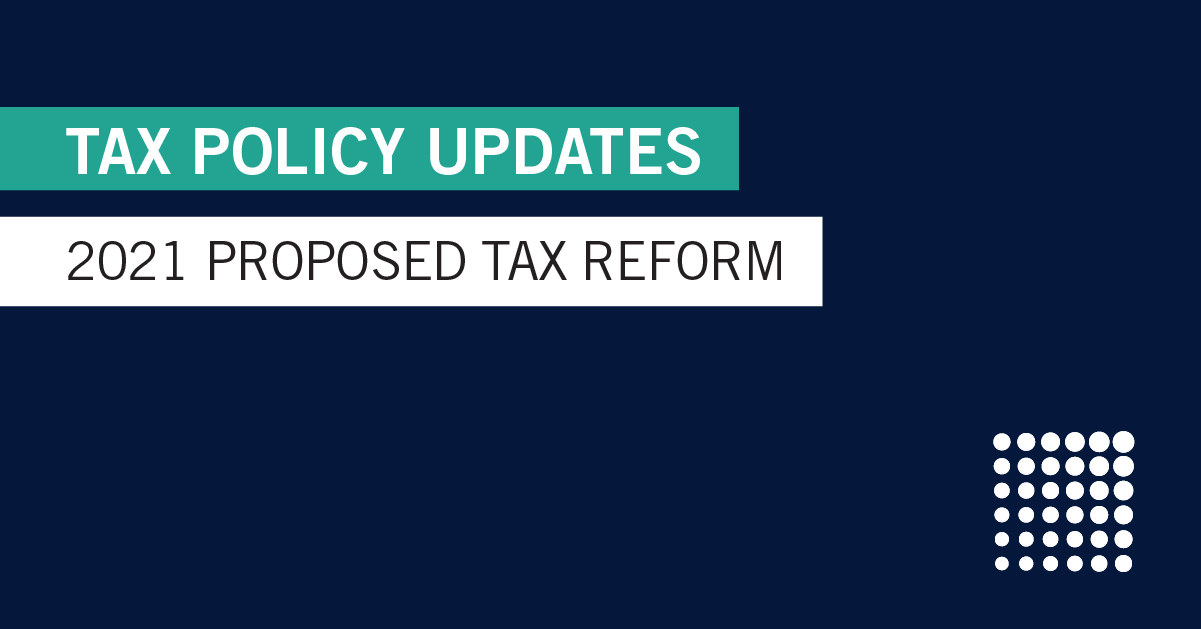What proposed changes mean for high-income earners
In mid-September, House Democrats released the details of their proposed tax plan. The proposal is expected to raise more than $2 trillion in new revenue aimed specifically at businesses and at high-income individuals.
If passed without any changes, this will be one of the largest tax hikes on high-income individuals in decades. The bill still has an uphill battle in both the House and Senate, so it is likely there will be several changes before it is finalized later this year. However, CWA believes that tax reform is inevitable.
Here are the key elements of the proposal from the House Ways and Means Committee, as it stands now:
TAX INCREASES
Individual Rates: Under the proposal, the top individual ordinary income tax rate would rise from 37% to 39.6%—the rate prior to the Tax Cuts and Jobs Act of 2017.
This proposal would lower the income threshold of the highest tax bracket. The highest tax rate would apply to incomes at or above $450,000 for joint returns and $400,000 for individuals. The current top rate does not begin until incomes are greater than $628,300 for joint returns and $523,600 for single filers.
This means the top individual rate will affect many more dental professionals and many small business owners. For example, a dentist with $650,000 in taxable income would now pay about $9,000 more in federal taxes.
Capital Gains: The top capital gains tax rate would increase from 20% to 25% and would start for joint filers with $450,000 of income and $400,000 for single filers and would be effective as of September 13, 2021. As with the increased individual rates, the top capital gains rate would now affect many more dental professionals.
This becomes a significant tax increase when a doctor sells a practice and recognizes capital gains. A $1 million gain on the sale of a business will now pay $50,000 more in capital gains tax.
Other capital gains transactions would be when an individual sells a capital asset, such as a building or shares of stock in a personal taxable account. However, under the proposal the new higher rate does not apply to qualified dividends.
3% Surtax: The proposal also called for a 3-percentage-point surtax on individuals and married couples with adjusted gross income above $5 million. It is possible this could affect the tax a dental professional would pay with a practice sale above $5 million.
S-Corp Flow Through Income: The proposal, would impose a 3.8% Medicare net investment tax on S-Corporation profits. Currently, these profits are exempt from the 3.8% tax. The tax would be imposed if taxable income is greater than $400,000 (single filer) and $500,000 (joint filers).
We will need to wait to see any final regulations from the IRS on how this will be calculated. Worst-case scenario is a business owner with taxable income of $650,000 with $350,000 of S-Corp profits may pay up to an additional $13,300 in tax. Couple this increase with the increased individual rates and a doctor with $650,000 of income could see total increased taxes of over $20,000 annually or about a 3.4% tax increase.
Corporate Tax Rate: The plan would raise the corporate tax rate to 26.5% from 21%. The proposed legislation includes a graduated corporate tax bracket system, however, personal service corporations, which include dental practices structured as C-Corporations, would not get the benefit of the graduated brackets. This doesn’t affect most dental professionals since all profits are usually bonused out and therefore are not subject to corporate tax.
Qualified Business Income (QBI): The proposal would also pare back a tax break for businesses that pay their taxes on their owners’ individual tax returns. Those companies, such as partnerships and S-Corporations, would face caps on a deduction they got in the 2017 tax law. The plan would limit the deduction at $500,000 for joint filers, $400,000 for individuals and $250,000 for a married person filing a separate return.
Overall, this should not affect many of our dental practices since they are considered specified service businesses and the QBI is already phased out with income between $315,000 to $415,000. Most CWA clients have income thresholds above this amount, which make this change less relevant to them.
RETIREMENT & ESTATE
Roth IRA Conversions: The bill would eliminate Roth IRA conversions for joint filers above $450,000 and single filers above $400,000 beginning in 2032. If passed, planning over the next 10 years would be critical to try to convert existing pre-tax IRAs or rollover IRAs to Roth IRAs.
After-Tax IRAs: IRAs funded with after-tax dollars would be prohibited from being converted to Roth IRAs regardless of income beginning in 2022. This effectively eliminates the “back door” Roth IRA.
Large IRAs: Individuals that have total retirement account balances (excludes defined benefit and cash balance plans) in excess of $10 million and income greater than $400,000 (single) or $450,000 (married) will no longer be able to contribute to IRA or Roth IRAs.
Additionally, individuals above these same thresholds would be required to take a 50% minimum distribution of any amount above the $10 million limit in the following year and must be taken from Roth IRAs first.
With many younger dentists being able to contribute at higher limits to 401(k) plans than ever before, it is possible to achieve this level of wealth long-term, and many of our clients will likely enter this realm over their careers. Additionally, an investor with a highly appreciated stock in an IRA may hit this level of wealth.
Estate Exemption: The current $11.7 million per person exemption would be decreased back to $5 million and increased for inflation since 2010. This change would dramatically lower the exemption a married couple could shelter from estate taxes from $23.4 million to $10 million, but will be increased due to inflation.
This potentially creates some gifting ideas for high-net-worth estates prior to December 31, 2021. CWA clients in this category should visit with their estate attorney.
STEPS TO PREPARE TO MINIMIZE THE IMPACT
First, investors and small business owners should not panic or start making decisions until a final law is known. CWA will continue to recognize planning first and not making decisions simply related to tax. However, here are some big-picture ideas to begin thinking about:
- Accelerate income into 2021 to take advantage of lower top rates and no S-Corporation profit net investment tax.
- Push year-end equipment purchases or large Q4 expenses into Q1 to reduce 2022 income.
- Do not rush to sell appreciated stocks and recognize capital gains until any law is known about backdating the increase to September 13, 2021.
- Visit with your estate attorney now about any gifting ideas.
- If you have not funded your 2021 IRA and converted to Roth you should do this prior to December 31, 2021.
- If your income is above $450,000 and is expected to remain above $450,000 you should discuss with your financial advisor if converting large pre-tax or rollover IRA balances to Roth before year-end would make sense to your financial plan.
- Visit with your CWA planner on increasing qualified retirement plan contributions through maximizing your 401(k) or cash balance plan.
The CPAs and advisors at CWA guide their clients through each season of tax law change, offering confidence and peace of mind in changing environments. Be prepared for 2022 by contacting a member of our team for a complimentary consultation.














